 | |
| Sahrang ("tricolour") | |
| Use | National flag and ensign |
|---|---|
| Proportion | 4:7 (see below) |
| Adopted | 7 October 1907 (original version, 1:3 ratio) 1964 (4:7 ratio) 29 July 1980 (current version) |
| Design | A horizontal tricolor of green, white and red with the National Emblem in red centred on the white band and the Takbir written in the Kufic script in white, repeated 11 times along the bottom edge of the green band and 11 times along the top edge of the red band, for a total of 22 times on the fringe of the bands. |
| Designed by | Hamid Nadimi |
The national flag of Iran,[lower-alpha 1] also known as the sahrang,[lower-alpha 2] is a tricolor featuring the Pan-Iranian colors comprising equal horizontal bands of green, white and red with the Nishan Rasmi ("Allah") in red centred on the white band and the takbir written 11 times each in the Kufic script in white, at the bottom of the green and the top of the red band.[1] After the Iranian Revolution of 1979, the present-day flag was adopted on 29 July 1980.
Many Iranian exiles opposed to the Iranian government use alternate flags, including the Iranian monarchy tricolor flag with the Lion and Sun at the center,[2] or the tricolor without additional emblems.
Flag description
Emblem

The parliament of Iran, per the 1980 constitution, changed the flag and seal of state insofar as the Lion and Sun were replaced by the red emblem in the centre of the flag. Designed by Hamid Nadimi,[3] and officially approved by Parliament and the Leader Grand Ayatollah Khomeini on 9 May 1980, this emblem is a highly stylised composite of various Islamic elements: a geometrically symmetric form of the word Allah ("God") and overlapping parts of the phrase lā ʾilāha ʾillā l-Lāh (There is no God Except Allah), forming a monogram consisting of four crescents and a line in the shape of a tulip. The four crescents read from right to left; the first crescent is the letter aleph, the second crescent is the first laam; the vertical line is the second laam, and the third and fourth crescents together form the heh. Above the central stroke is a tashdid (a diacritical mark indicating gemination) resembling "W". The tulip shape of the emblem as a whole memorialises those who have died for Iran and symbolises the values of patriotism and self-sacrifice, building on a legend that red tulips grow from the shed blood of martyrs. This emblem is somewhat similar to the Khanda but has no relation to Sikhism and its meaning to that religious community.
Kufic script
Written in white and repeated eleven times on the inner edges of each the green and the red band is the phrase Allahu Akbar (God is the greatest) in a stylised version of the kufic script. This symbolises the calls of Allahu Akbar on the night of 22 Bahman (11 February 1979) when the national radio of Iran broadcast: "From Tehran, the voice of the Islamic Republic of Iran" and marked the unofficial beginning of the Islamic Republic (with the official day being 2 May). This writing renders the flag non-reversible.
Colours
The colours of the Iranian flag are traditional, probably dating from at least the 18th century, and they can be interpreted as representing the Islamic religion (green), peace (white), and courage (red).[4]
Cyrus the Great, a Persian, defeated his grandfather Astyages, the High Judge (King) of the Medes, and founded Iran by uniting the Persians and the Medes. The Iranian flag (which was later designed under Darius I the Great) symbolised this unity and victory (green above white and red) as the flag of the people of Iran.[5]
Colours scheme
| Green | White | Red | |
|---|---|---|---|
| RGB | 35/159/64 | 255/255/255 | 218/0/0 |
| Hexadecimal | #239f40 | #FFFFFF | #da0000 |
| CMYK | 78/0/60/38 | 0/0/0/0 | 0/100/100/15 |
Construction
.svg.png.webp)
Physical requirements for the Iranian flag, a simple construction sheet, and a compass-and-straightedge construction for the emblem and the takbir are described in the national Iranian standard ISIRI 1.[6][7] The flag's aspect ratio is explicitly set at 4:7 in the standard. Several other sizes of parts of the flags are described in the simple construction sheet, but these values are not all consistent with the precise values obtained if following the classical construction.
History

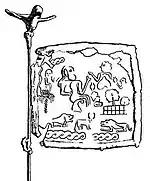
.svg.png.webp)

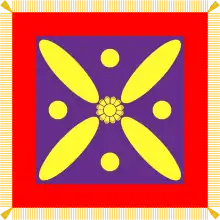
Flags, standards, and banners have always been important national and imperial symbols for Iranians, both in war and peace. Xenophon reports that Cyrus the Great's standard was a golden eagle with spread wings, mounted on a long shaft.
The best-known symbol of Iran in recent centuries has been the Lion and Sun motif, which is a graphic expression of the astrological configuration of the sun in the sign of Leo, although both celestial and animal figures have long and independent histories in Iranian heraldry. Late in the nineteenth century the Lion and Sun motif was combined with an earlier scimitar motif and superimposed on a tricolour of green, white, and red. With minor modifications, this remained the official flag until the revolution of 1979.
Prehistory
The oldest flag found in Iran is the Bronze Age Shahdad Standard, found in Shahdad, Kerman Province, dating back to c. 2400 BCE, made of bronze. It features a seated man and a kneeling woman facing each other, with a star in between. This iconography can be found in other Bronze Age pieces of art in the area as well.[8][9][10][11]
Achaemenid empire
The Old Persian word for "banner, standard" was drafša- (Avestan drafša-, Middle Persian drafš, cognate with Sanskrit drapsá-). Xenophon in Cyropaedia (7.1.4) describes the standard of Artaxerxes II at Cunaxa as "a golden eagle, with outspread wings, borne aloft on a long spear-shaft",[12] the same banner recorded to be used by Cyrus the Great.[13]
According to Herodotus (9.59), each Persian army division had its own standard, and "all officers had banners over their tents" (Xenophon, 8.5.13). One such banner, a square plaque in saltire, is depicted on a Greek vase, the so-called "Douris cup" held by the Louvre.[14] A similar design is known from an Urartian bronze disk from Altıntepe.[15] Similar square plaques on poles are known from six of the audience scenes of the Throne Hall relief at Persepolis.[16] The Alexander Mosaic of Pompeii, a Roman-era copy of a Hellenistic painting dated c. 320 BCE, also shows the royal Persian standard.,[17] depicted as a rectangular plaque, possibly originally in purple, with a dark red border with yellow dots. In the field, a golden bird is only partially preserved. The "royal falcon" of Persia (varəγna) represented farr or "glory", while the eagle was associated with the Achaemenid dynasty itself.[18]
A square tile representing a miniature (12 cm2) banner was discovered at Persepolis in 1948.[19] The tile is made of Egyptian blue frit and likely represents Ancient Egyptian Horus, but in the Persian context suggests local association with the Avestan varəγna or the royal eagle of the Achaemenids.[20]
Sassanid empire
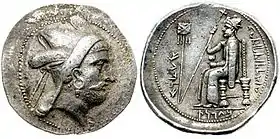
In Sassanid times the imperial flag was a leather rectangle covered with a thin layer of silk ornamented with jewels, with a four-pointed star at the centre, indicating the four corners of the world. This is the same star referred to as Akhtare Kaviani ("the Kaviani star") by Ferdowsi in the epic Shahnameh (Book of Kings). The flag was larger than the original Derafsh Kaviani apron and suspended from a lance, the point of which appeared above it. Attached to the lower edge were tassels of yellow, magenta, and scarlet, with large pendant jewels. The flag was destroyed by invading Muslim Arabs after their decisive defeat of the Sassanids.
Seljuk Empire
Various emblems and banners have been recorded to be used by the Seljuks in different periods. Early Seljuks were using their traditional emblems, but they gradually adopted local Muslim emblems and banners. The official flag of the empire was most probably a black flag, similar to the flag of the Abbasid Caliphate. The flag was decorated with emblems, which were either superimposed over it or was placed above the flag.[22] This black flag was traditionally presented to the Seljuk sovereigns by the Abbasid caliphs.[23]
A yellow flag was also used to denote Seljuk sovereignty over a town.[23]
Ghaznavid dynasty
The Turkic Ghaznavid dynasty were invested in promoting Iranian culture. They are known to have displayed a number of heraldic emblems that harked back to pre-Islamic Iran, including the Sun and Lion motif, as well as the Griffin motif.[24] Their banners appear to have shown chequered motifs.[25]
Safavid dynasty
The Safavid dynasty (1501–1736) used three green flags, each with a different emblem. Ismail I, the first Safavid king, designed a green flag with a golden full moon. In 1524 Tahmasp I replaced the moon with an emblem of a sheep and sun; this flag was used until 1576. It was then that Ismail II adopted the first Lion and Sun device, embroidered in gold, which was to remain in use until the end of the Safavid era. During this period the Lion and Sun stood for two pillars of the society: the state and religion. Although various alams and banners were employed by the Safavids (especially during the reign of the first two kings), by the time of Shah Abbas I the Lion and Sun symbol had become one of the most popular emblems of Iran.
The Safavid interpretation of this symbol is believed to have been based on a combination of historical legends like the Shahnameh, stories of prophets, and other Islamic sources. For the Safavids the king (shah) had two functions: he was both a ruler and a holy personage. This double role was considered the patrimony of the Iranian kings, derived from Jamshid, mythical founder of the ancient Persian kingdom, and Ali, the first Shi'a Imam. Jamshid was associated with the sun and Ali with the lion (from his epithet "Lion of God"). The correspondence may originally have been based on a learned interpretation of the Shahnameh references to "the Sun of Iran" and "the Moon of the Turanians". Since the crescent moon had been adopted as the dynastic (and ultimately national) emblem of the Ottoman sultans, who were the new sovereigns of Rum, the Safavids of Iran, needing to have a dynastic and national emblem of their own, chose the Lion and Sun motif. The sun had further important meanings for the Safavid world, where time was organised around a solar calendar, in contrast to the Arabo-Islamic lunar system. In the zodiac the sun is linked to Leo; for the Safavids the Lion and Sun symbol conveyed the double meaning of the royal and holy figure of the shah (Jamshid and Ali), the auspicious astrological configuration bringing the cosmic pair and the earthly—king and imam—together.
Regarding the Safavid understanding of the Lion and Sun motif, Shahbazi suggests that "the Safavids had reinterpreted the lion as symbolizing Imam ʿAlī and the sun as typifying the 'glory of religion', a substitute for the ancient farr-e dīn." They reintroduced the ancient concept of God-given glory (farr) to justify their rulership, attributing these qualities to Ali while tracing the king's genealogy through the Shia Fourth Imam's mother to the royal Sassanian house.
Flags
.svg.png.webp)
Flag of Safavid dynasty under Ismail I (1501–1524)

Flag of Safavid dynasty under Tahmasp I (1524–1576)

Flag of Safavid dynasty after Ismail II (1576–1732)
 Flag of Iran carried by the Persian delegation during Mohammad Reza Beg's visit to Versailles, August 1715
Flag of Iran carried by the Persian delegation during Mohammad Reza Beg's visit to Versailles, August 1715
Afsharid dynasty
Nader Shah consciously avoided the using the colour green, as green was associated with Shia Islam and the Safavid dynasty.[26]

The two imperial standards were placed on the right of the square already mentioned: one of them was in stripes of red, blue, and white, and the other of red, blue, white, and yellow, without any other ornament: though the old standards required 12 men to move them, the SHAH lengthened their staffs, and made them yet heavier; he also put new colours of silk upon them, the one red and yellow striped, the other yellow edged with red: they were made of such an enormous size, to prevent their being carried off by the enemy, except by an entire defeat. The regimental colours were a narrow slip of silk, sloped to a point, some were red, some white, and some striped.[27][28]
Navy Admiral flag being a white ground with a red Persian Sword in the middle.[29] Although based on the writings of Jonas Hanway, we can see that the flags of the army regiments of King Nader were three-eared, but we cannot come to a conclusion about whether the royal flags of that time were three-eared or four-eared.
Flags
.svg.png.webp)
An Imperial Standard of the Afsharid dynasty
.svg.png.webp)
Another Imperial Standard of the Afsharid dynasty
_-_No._1.svg.png.webp)
Nader Shah's flag

Naval flag of Afsharid period
Zand dynasty
The state flag of the Zand dynasty was a white triangular pennant with a green border and a gold lion and sun in the centre.[30] Another version included the same design but with green and red.
Flags

Flag of the Zand Dynasty
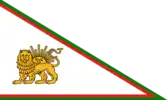
Another Flag of the Zand Dynasty
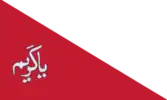
The "Ya Karim" flag, which was a pun on Karim Khan Zand's name, and Al-Karim (the generous), which is one of the Islamic names of God
Early Qajar dynasty
Few sources directly describe the national flag during Agha Mohammad Khan Qajar's reign. Gholam Hossein Afzal ol-Molk refers to the Beyraq Qapuq (execution flag) of the Naserid period as originating from Agha Mohammad Khan's time.[31] This pennon flag is red and displays the lion and sun motif with a sword, although it is unlikely that the emblem resembled that of Agha Mohammad Khan's time given the sword-less design on the coins of this era. Several modern sources attribute a square flag with a red background and a pale yellow circle in the center, featuring a lion and a sun motif with a sword, to the period of Agha Mohammad Shah. The only visible source for this design is an unidentified portrait of Agha Mohammad Shah, where such a banner is present next to him. This painting was featured on the cover of the 1992 book Les Rois oubliés: L'épopée de la dynasty Kadjare, by Ali Mirza Qajar (grandson of Mohammad Ali Shah Qajar). Moreover, the painting was also photographed at a Qajar family gathering at Chateau de Bonmont, Cheserex, Switzerland in 2003.[32] Although the painting may belong to members of the Qajar family, no other source has confirmed the prevalence of such a flag during Agha Mohammad Khan's reign. Additionally, the prominence of pennon or triangular flags during this time questions the accuracy of the square flag.
In contradistinction, various contemporary and modern sources provide more detailed descriptions of Iranian flags and the development of the lion and sun motif during Fath-Ali Shah's rule, particularly in military contexts. Colonel Gaspard Drouville, a French officer who served as a military instructor for the Iranian government after the signing of the Treaty of Finckenstein, authored a two-volume travelogue that offers additional information on Iranian flags and standards.[33]

Drouville expounds that in 1813, Fath-Ali Shah Qajar and Abbas Mirza attended a royal inspection of the regular infantry in Azarbaijan to personally confer each standard to their respective corps.[34] These flags included the lion and sun motif, a date or number pertaining to the unit, and the inscription: "Sultan ibn Sultan Fath-Ali Shah Qajar" (Sultan son of Sultan Fath-Ali Shah Qajar), in reference to Abbas Mirza's title.[34] The flags and standards are further described as similar to those of the French, adorned with taffeta white streamers and golden fringes.[34] Based on Drouville's illustration, the larger flags of the regular infantry were painted red, and the flagpole was crowned by the silver Hand of Ali. The smaller standards that were prescribed to the cavalry lancers were a deep blue and featured a crouching lion brandishing a curved sword before a setting sun. These standards were topped by golden spears that were "as sharp as those of the Houlans".[35]
The depiction of a sword-wielding lion on a blue-colored flag in Drouville's book is a noteworthy observation, as it represents an early instance of the lion and sun emblem associated with a sword. Drouville's travels to Iran took place between 1812 and 1813, but his book was not published until 1825. This leaves open the question of when exactly the flag evolved to include the sword-wielding lion and sun motif.

An illustration by the French battle painter Joseph Louis Hippolyte Bellangé depicts Abbas Mirza reviewing Persian regular troops. The infantry corps carries a standard with a spearhead finial bearing a couchant lion and sun with a sword, similar to the cavalry flag of the Nezam lancers depicted by Drouville. However, as the work dates to 1835, two years after Abbas Mirza's death, the flag's design may be an artistic oversight.[36]
_and_a_military_banner.jpg.webp)
In his accounts of the Russo-Persian war, Captain Yermolov, the Russian commander-in-chief in the Caucasus, documented the Iranian military in detail. One excerpt from his notes provides a vivid portrayal of a Nezam drummer, soldier, and officer carrying a Sarbaz infantry military banner dated to 1817. This banner, which shares many similarities with contemporary European regimental flags, features a lion and sun motif devoid of a sword within a white lozenge accented by a golden border. The light blue banner boasts a flagpole crowned by the silver Hand of Ali.[37]


A painting, believed to be the work of Allahverdi Afshar between 1814 and 1817, which adorned the walls of Abbas Mirza's Ojan castle portrays the Iranian triumph at the Battle of Sultanabad on 13 February 1812. The painting exhibits Persian troops carrying banners of Napoleonic style, featuring the passant lion and sun equipped with a sword.[38]
No contemporary sources have made any other indications of a sword wielded by the lion until the reign of Mohammad Shah.[33] Nonetheless, this illustration provides valuable insight into the evolution of the emblem and its use on Iranian flags during the Qajar period.[39] However, Zoka mentions the inscription of a coin from the Urmia mint, dated 1833 (1249 AH), in which a couchant lion is depicted holding a sword. According to Zoka, these sources prove that the earliest representation of the sword-wielding lion and sun pre-dates the reign of Mohammad Shah and was likely institutionalized in the latter years of Fath-Ali Shah's reign.[39]
During Fath-Ali Shah's reign, the state flag and other flags adopted by the Iranian government purportedly opted for square or rectangular shapes over the pennon flags commonly used in earlier eras. Another distinction noted in the designs of the lion and sun depicted on coins and flags of Fath-Ali Shah's era relative to those of prior years is the appearance of the lion. Before the middle of Fath-Ali Shah's reign, a Persian lion, which is maneless and smaller in stature was prominent, whereas later depictions evolved to an African lion.[39] Towards the end of Fath-Ali Shah's reign the two common symbols of the Qajar empire were combined to include the Zulfiqar and the lion and sun in the official flag.[40]
While there is little evidence, several modern sources state that Fath-Ali Shah adopted three different state flags; a plain red flag with a couchant lion and sun motif as the war flag, a plain white flag with a couchant lion and sun for diplomatic purposes, and a green flag with a lion passant in front of the setting sun, wielding a sword during peacetime.[30][41]
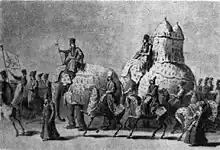
Alexis Soltykoff's Voyage en Perse includes an illustration depicting a standing lion wielding a sword. The painting is titled "Entrée de l'ambassade de Perse a St. Petersbourg" (Entrance of the Persian Embassy to St. Petersburg) and shows the arrival of Mirza Abolhassan Khan Ilchi, then the Iranian ambassador to Russia, in 1838. The image features a Persian standard-bearer holding a rectangular flag with a lion passant, holding a curved sword in front of the setting sun. Atop the flagpole is the Hand of Ali finial. The painting was included in Soltykoff's book, which was published in 1851, several years after the events it depicts.[42]
French orientalist Louis Dubeux stated that one of the privileges enjoyed by the Shah of Iran was the right to "raise" several flags. Dubeux suggests that Mohammad Shah had two flags. He describes one of these flags as displaying the Zulfiqar while the other depicted a couchant lion and sun motif.[43]
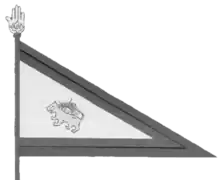
While Iranian flags and military banners were largely uniform and similar in design by Mohammad Shah's reign, Ahmad Naqash's 1860 oil painting depicting the successful Iranian siege of the fort of Ghurian in 1837 serves as a contradictory source of information. Several noteworthy discrepancies arise. Firstly, the use of pennon banners is unusual as square and rectangular flags were more prominently used in Iran and adopted by the military at that time. Secondly, the sword-less lion and sun motif depicted in the painting is outdated. Thirdly, the white and green color combination contradicts contemporary literature describing military banners and standards as being red or blue. According to Zoka, the painter may have relied on local designs as the work likely originated from Isfahan or Shiraz, where forts in the provinces often raised flags different from those in Tehran. Zoka also suggests that the Herat expedition's army could have reused dated standards predating the new designs.[42]
Under Nasser al-Din Shah, the principal flag was white with a green border on three sides and a lion and emblem in the centre.[44][45] There was also a naval ensign which had a red and green border and a civil ensign which looked the same as the naval ensign but without the lion and sun in the middle.[44][46]
All flags had a 3:4 ratio.
Flags

Flag of Mohammad Khan

War flag of Fat′h Ali Shah

Diplomatic flag of Fat′h Ali Shah
.svg.png.webp)
Peace flag of Fat′h Ali Shah (version with sword)

Flag used during the reign of Mohammad Shah
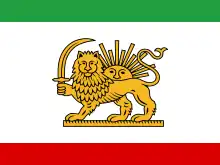
Tricolour flag designed by Amir Kabir, State flag 1848–1852

State flag 1852–1907

Civil ensign until 1906

Naval ensign until 1906
.svg.png.webp)
Tricolour flag reported in 1886
Post-Constitutional Revolution
.svg.png.webp)
The first version of the modern Iranian tricolour was adopted in the wake of the Iranian Constitutional Revolution of 1906.[46] The Supplementary Fundamental Laws of 7 October 1907 described the flag as a tricolour of green, white, and red, with a lion and sun emblem in the middle.[47] A decree dated 4 September 1910 specified the exact details of the emblem, including the shape of the lion's tail ("like an italic S") and the position and the size of the lion, the sword, and the sun.[48]
During this period, the colours of the flag were very pale, with the red appearing closer to pink in practice. There were three variants of the flag in use. The state flag was a tricolour with the lion and sun emblem in the centre. The national flag and civil ensign was a plain tricolour with no emblem. The naval ensign and war flag was similar to the state flag, but the emblem was surrounded by a wreath and surmounted by a crown. All three flags had a 1:3 ratio.[46]
The flag was modified twice during the Pahlavi era. In 1933, the colours of the flag were darkened and the design of the emblem was changed. The sun's facial features were removed and the Kiani Crown on the naval ensign was replaced with the Pahlavi Crown.[49] In 1964, the ratio was changed from 1:3 to 4:7 and the emblem on the naval ensign was shrunk to fit entirely within the white stripe.[50]
Following the Iranian Revolution, the Interim Government of Iran removed the crown from the naval ensign. The old state and national flags remained unchanged until 29 July 1980, when the modern Iranian flag was adopted.[51]
Historical flags
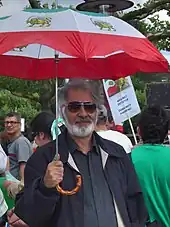
| Years | Naval ensign | Civil flag | State flag |
|---|---|---|---|
| 1736–1747 |
|
|
|
| 1797–1834 |
|
|
|
| 1834–1848 |
| ||
| 1848–1852 |
| ||
| 1852–1906 |
|
|
|
| 1906–1907, 1910–1933 |
|
|
|
| 1933–1964 |
|
|
|
| 1964–1979 |
|
|
|
| 1979–1980 |
|
|
|
| 1980–present |
|
|
|
The new Iranian government viewed the Lion and Sun symbol as representing the "oppressive Westernising monarchy" that had to be replaced, despite the emblem's traditional Shi'a meanings and the lion's association with Ali, the first Imam of the Shi'a.[53] For that reason, the name of the Red Lion and Sun Society was changed to Red Crescent Society.
Currently, the Lion and Sun flag is used by Iranian communities in exile as a symbol of opposition to the Islamic Republic. Some political groups in Iran, including monarchists, continue to use it as well. In Los Angeles, California and other cities with large Iranian expatriate communities, the Lion and Sun, as a distinguishing marker, appears on Iranian flags and souvenirs to an extent that far surpasses its display during the years of monarchy in its homeland, where the plain tricolour was usually used. After the Islamic Revolution in Iran and the replacement of the lion and sun flag with the new flag, new designs of this flag were still presented, prominently by the MeK.[2]
Mahsa Amini Protest
The tri-color Iran flag with the writing "Women Life Freedom" has been used during the Mahsa Amini protests that began in September 2022. Participants held up Iranian flags during the diaspora protests in Berlin, many with the tagline "Women, Life, Freedom" in both English and German.[54] During the Qatar World cup many Iranians carrying protest flag had the flags confiscated by the stadium security at the behest of Iranian government's request.[55]
Note
See also
References
Citations
- ↑ Constitution of the Islamic Republic of Iran: Chapter II, Article 18: "The official flag of Iran is composed of green, white and red colours with the special emblem of the Islamic Republic, together with the motto (Allahu Akbar)."
- 1 2 Najmabadi, Afsaneh (2005), "II", Women with Mustaches and Men without Beards: Gender and Sexual Anxieties of Iranian Modernity, University of California Press, ISBN 0-520-24262-9
- ↑ "Tehran Municipality honors Islamic Revolution artists". Tehran Times. Retrieved 6 October 2010.
- ↑ Shaw, Carol P. (1994). Collins Gem Flags (3rd ed.). United Kingdom: Harper Collins: Glasgow. p. 240. ISBN 978-0-00-470723-5.
- ↑ Koch, Heidemarie 1989: Persepolis. Theran Yasavoli
- ↑ ISIRI 1 Archived 1 November 2013 at the Wayback Machine (in Persian), 1st revision. Retrieved 19 June 2012
- ↑ ISIRI 1 / IRANIAN ISLAMIC REPUBLIC FLAG, 1371 Archived 21 June 2012 at the Wayback Machine (in Persian), 3rd edition, March 1993. Retrieved 19 June 2012.
- ↑ Graef, Katrien De; Tavernier, Jan (7 December 2012). Susa and Elam. Archaeological, Philological, Historical and Geographical Perspectives.: Proceedings of the International Congress Held at Ghent University, December 14–17, 2009. BRILL. ISBN 978-9004207400 – via Google Books.
- ↑ Pittman, Holly; N.Y.), Metropolitan Museum of Art (New York (12 December 1984). Art of the Bronze Age: Southeastern Iran, Western Central Asia, and the Indus Valley. Metropolitan Museum of Art. ISBN 9780870993657 – via Google Books.
- ↑ Hansen, Donald P.; Ehrenberg, Erica (12 December 2017). Leaving No Stones Unturned: Essays on the Ancient Near East and Egypt in Honor of Donald P. Hansen. Eisenbrauns. ISBN 9781575060552 – via Google Books.
- ↑ Hakemi, Ali; Archeologiche, Istituto italiano per il Medio ed Estremo Oriente Centro Scavi e Ricerche (12 December 1997). Shahdad: archaeological excavations of a bronze age center in Iran. IsMEO. ISBN 9788120410176 – via Google Books.
- ↑ George Henry Preblem, The Symbols, Standards, Flags, and Banners of Ancient and Modern Nations, The Flag Research Center (1980).
- ↑ Alireza Shapur Shahbazi (December 15, 1994), "DERAFŠ", Encyclopaedia Iranica, Vol. VII, Fasc. 3, pp. 312–315.
- ↑ E. Pottier, Douris, London, 1909, p. 105 fig. 20, Plate XXV.b
- ↑ O. A. Taşyürek, "Darstellungen des urartischen Gottes Haldi", in: S. Şahin, E. Schwertheim, J. Wagner (eds.), Studien zur Religion und Kultur Kleinasiens. Festschrift für Friedrich Karl Dörner, Leiden, 1978, p. 942 fig. 7; pl. CCXVIII/4–5.
- ↑ E. F. Schmidt, Persepolis I, III, Chicago, 1953, 1970., p. 166, pls. 98, 99, 123.
- ↑ T. Hölscher, Griechische Historienbilder des 5. und 4. Jahrhunderts v. Chr., Würzburg, 1973, pp. 122–69, 270–88.
- ↑ Aelian, De Natura Animalium 12.21 has a legend of Achaemenes having been raised by an eagle. Ezra (18:13) has "Eagle of the East" in reference to Cyrus.
- ↑ Īrān-Bāstān Museum, Tehran, no. 2436; Sāmī, Persepolis, tr. R. Sharp, Shiraz, 1970, fig. facing p. 100; H. Luschey, "Ein königliches Emblem", AMI 5, 1972, pp. 257–60.
- ↑ A. Shapur Shahbazi, DERAFŠ, Encyclopedia Iranica (1994, 2011).
- ↑ Wiesehöfer, Josef. "FRATARAKA". Encyclopædia Iranica. Retrieved 22 July 2012.
- ↑ کوپریلی، فؤاد (۱۳۷۹). «پرچم٫ ۱:تاریخچه پرچم در جهان اسلام». در حداد عادل، غلامعلی. دانشنامه جهان اسلام. ۵. تهران: بنیاد دایرةالمعارف اسلامی. بایگانیشده از اصلی در ۱ آوریل ۲۰۲۰.
- 1 2 Güzel, Hasan Celâl; Oğuz, Cem; Karatay, Osman (2002). The Turks: Middle ages. Yeni Türkiye. p. 595.
- ↑ K. Farrokh, The Lion and Sun Motif of Iran: A brief Analysis (2009), citing S. Nafisi, Derafsh-e Iran va Shir o Khoshid [The Banner of Iran and the Lion and the Sun]. Tehran: Chap e Rangin (1949), pp. 45, 48–58; G.H. Yusofi, Farrokh e Sistani. Mashad, (1962), p. 422.
- ↑ based on the History of Rashid-al-Din Hamadani, see Rice, D. T., & Gray, B., The Illustrations of the "World History" of Rashīd al-Dīn, Edinburgh (1967), plates 38, 44, 57, 60.
- ↑ Shapur Shahbazi|1999|Encyclopædia Iranica
- ↑ Hanway, Jonas (1753). "XXXVII". An Historical Account of the British Trade over the Caspian Sea: With a Journal of Travels through Russia into Persią. 248-249. London: Mr. Dodsley. Retrieved 15 January 2020.
- ↑ "An Historical Account of the British Trade over the Caspian Sea Vol.1,2". 1753.
- ↑ Nādir Shāh's Campaigns in 'Omān, 1737–1744 By Laurence Lockhart, Bulletin of the School of Oriental Studies, University of London,Vol. 8, No. 1 (1935), pp. 157–171
- 1 2 "The Lion and Sun Motif of Iran: A brief Analysis". Dr. Kaveh Farrokh. Retrieved 12 November 2010.
- ↑ ببریدیزج, مهربان (1388). "انواع بیرق و کاربردهای آن در نتایج یک پژوهش عهد ناصری" (PDF). يام بهارستان: 908.
- ↑ "Meine Familie - Home". 3 April 2019. Archived from the original on 3 April 2019. Retrieved 10 April 2023.
- 1 2 Zoka, Yahya (1344). "تاریخچه تغییرات و تحولات درفش و علامت دولت ایران از آغاز سده سیزدهم هجری قمری تا امروز" (PDF). هنر و مردم: 14.
- 1 2 3 Drouville, Gaspard (1825). Voyage en Perse, fait en 1812 et 1813, Volume 1 (in French). Masson et Yonet. p. 116.
- ↑ Drouville, Gaspard (1825). Voyage en Perse, fait en 1812 et 1813, Volume 1 (in French). Masson et Yonet. p. 118.
- ↑ "Brown Digital Repository | Item | bdr:231139". repository.library.brown.edu. Retrieved 10 April 2023.
- ↑ "PERSIAN REGULAR ARMY OF THE FIRST HALF OF THE 19TH CENTURY (part 1)". warfare.tk. Retrieved 10 April 2023.
- ↑ "The Battle of Sultanabad, Persia, 1812". warfare.6te.net. Retrieved 11 April 2023.
- 1 2 3 Zoka, Yahya (1344). "تاریخچه تغییرات و تحولات درفش و علامت دولت ایران از آغاز سده سیزدهم هجری قمری تا امروز". هنر و مردم: 15–16.
- ↑ "Encyclopædia Iranica: FLAGS i. Of Persia". Retrieved 12 November 2010.
- ↑ "Iranian Flag, A Brief History (English version)" (PDF). Archived from the original (PDF) on 26 July 2011. Retrieved 12 November 2010.
- 1 2 Zoka, Yahya (1344). "تاریخچه تغییرات و تحولات درفش و علامت دولت ایران از آغاز سده سیزدهم هجری قمری تا امروز (2)" (PDF). هنر و مردم: 33–34.
- ↑ Dubeux, Louis (1841). La Perse (in French). Paris: Firmin Didot frères. p. 462.
- 1 2 "Flags of the World: Persia (Iran) in the XIXth century". Retrieved 12 November 2010.
- ↑ Le Gras, M. A. (1858). Album des pavillons, guidons et flammes de toutes les puissances maritimes. Paris: Dépôt des Cartes et Plans de la Marine.
- 1 2 3 "Flags of the World: Iranian Empire (Qajar dynasty, 1905–1925)". Retrieved 10 November 2010.
- ↑
 Iran Constitution of 1906.
Iran Constitution of 1906. - ↑ Najmabadi (2005), p. 86.
- ↑ "Flags of the World: Iranian Empire (Pahlavi dynasty, 1925–1964)". Retrieved 10 November 2010.
- ↑ "Flags of the World: Iranian Empire (Pahlavi Dynasty, 1964–1979)". Retrieved 10 November 2010.
- ↑ "Flags of the World: Iran: Transition period (1979–1980)". Retrieved 10 November 2010.
- ↑ Najmabadi (2005), pp. 87–88.
- ↑ Babayan, Kathryn (2002), Mystics, Monarchs, and Messiahs: Cultural Landscapes of Early Modern Iran, Harvard College, p. 491, ISBN 0-932885-28-4
- ↑ "Protest against Iranian regime draws thousands in Berlin". ABC News. 22 October 2022.
- ↑ "Fans show support for 'Women, Life, Freedom' Iran human rights protests at Qatar World Cup". USA Today. 29 November 2022.


.svg.png.webp)
.svg.png.webp)
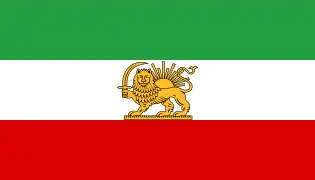
.svg.png.webp)
